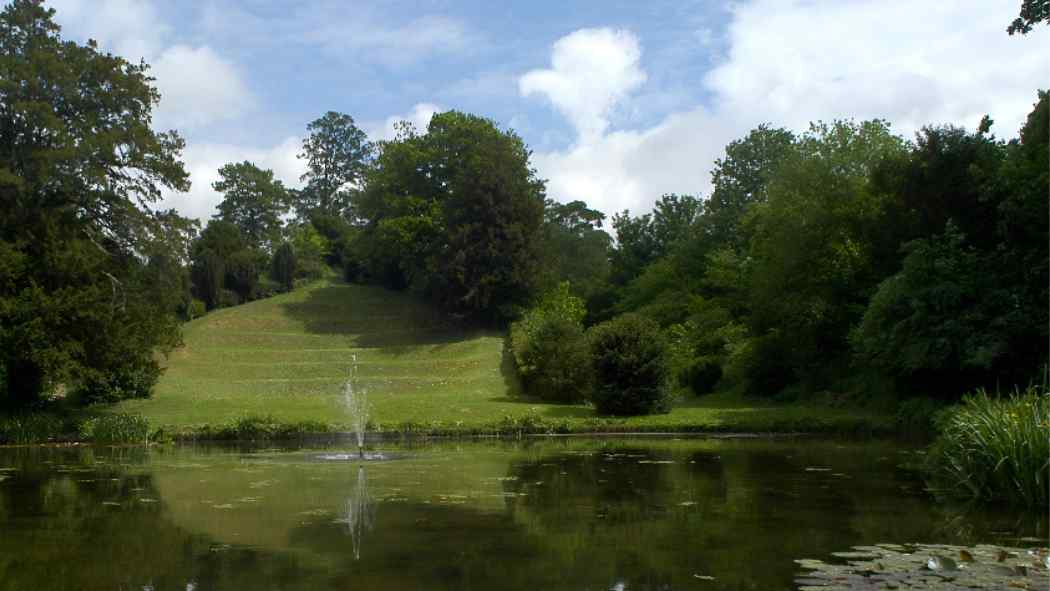Downton Moot: The Timeless Garden of History and Tranquillity

Nestled quietly in the village of Downton, near Salisbury in Wiltshire, England, lies a hidden historical gem known as Downton Moot. To many, it is a serene garden space offering beauty, peace, and a retreat into nature. But behind its calm exterior, Downton Moot carries centuries of English history — from Roman settlement remains to Norman fortifications and 18th-century landscape designs. It is not merely a public garden; it is a living chronicle of England’s layered past, shaped by time, nature, and human creativity.
Downton Moot is one of those rare places where history, archaeology, and natural beauty blend into one harmonious landscape. Its eight-acre setting by the River Avon reflects not just the aesthetic ambitions of those who landscaped it centuries ago, but also the deep heritage of the area itself. Understanding Downton Moot means exploring the many stories hidden beneath its gentle slopes and shaded paths — stories of power, architecture, art, and revival.
The Historical Roots of Downton Moot
The story of Downton Moot stretches back far before its creation as a landscaped garden. Archaeological findings suggest that the area surrounding Downton was settled during the Roman period. Traces of Roman villas and artefacts indicate a community that once thrived along the fertile banks of the River Avon. These early inhabitants were drawn by the same qualities that visitors appreciate today — a gentle river, lush greenery, and fertile soil.
The real transformation, however, occurred in the medieval era. Around the early 12th century, during the turbulent times of civil conflict in England known as The Anarchy, the Bishop of Winchester — a powerful churchman and brother to King Stephen — commissioned the construction of a motte-and-bailey fortification on this site. This castle, which came to be known as Downton Moot, served both as a defensive structure and a symbol of authority.
The term “moot” historically referred to a meeting place or assembly ground, and it is likely that the site’s name reflects its function as a place of governance and local importance. The castle itself, built mainly from timber, followed the design typical of early Norman military architecture: a raised mound (motte) surrounded by defensive ditches and embankments, with an enclosed bailey area for living quarters and storage.
Decline and Transformation
Following the civil unrest of the 12th century, many small castles and fortifications across England were dismantled or fell into disuse under King Henry II’s rule, as part of his effort to stabilise royal power. Downton Moot likely shared that fate, gradually losing its military purpose and slipping into ruin. Over time, the defensive earthworks were softened by vegetation, and the once-fortified site began to take on the appearance of natural rolling hills and grassy banks.
Centuries later, in the 18th century, this same landscape caught the imagination of designers during the age of English landscape gardening. The concept of turning former fortifications into picturesque pleasure grounds became popular among the gentry, who sought to blend natural beauty with historical romance. Downton Moot was reshaped into a garden of contemplation, leisure, and scenic charm. The old castle mound was repurposed as a focal feature within a designed landscape — a symbol of nostalgia for England’s medieval past.
The gardens were laid out with graceful lawns, wooded walks, and ornamental features such as a loggia, amphitheatre, and terraces. Trees were planted in deliberate patterns to frame views across the river and surrounding countryside. This transformation marked a turning point in Downton Moot’s identity — from a site of conflict to one of peace and reflection.
The 18th-Century Landscape Vision
During the Georgian period, landscape gardening was at the height of fashion. Landowners and designers aimed to create spaces that imitated nature while still being artistically planned. Downton Moot reflected these ideals beautifully. The natural contours of the medieval earthworks provided the perfect foundation for a romantic garden — one that spoke of history, harmony, and beauty combined.
Visitors in the 18th century would have wandered along winding paths, admired the views from the raised motte, and perhaps enjoyed musical or theatrical performances in the small open-air amphitheatre. The presence of the River Avon nearby enhanced the garden’s charm, offering reflections of trees and sky that deepened its sense of calm.
Unlike formal French gardens, which were rigid and symmetrical, Downton Moot followed the English preference for natural flow and variety. The garden’s layout invited quiet exploration rather than strict order. This philosophy of design mirrored broader cultural changes — a growing appreciation of nature’s imperfection and a shift towards emotional and poetic responses to the landscape.
Nature’s Influence and the Passing of Time
Over the centuries, nature continued to reshape Downton Moot. Trees matured, flowers spread, and the once-manicured lawns became more natural in appearance. While this gradual transformation blurred the original outlines of its design, it also added an authentic, timeless beauty.
However, not all changes were gentle. In 1987, a powerful hurricane struck southern England, causing widespread damage to woodlands and gardens — and Downton Moot was not spared. Many old trees were lost, altering the landscape dramatically. Yet, as often happens in the story of English gardens, renewal followed loss. Local volunteers and conservation groups stepped in to restore and preserve what remained, ensuring that Downton Moot would continue to welcome future generations.
The Present-Day Downton Moot
Today, Downton Moot stands as a public garden managed with care and respect for its layered history. Covering roughly eight acres, it offers open lawns, wooded paths, and gentle slopes that hint at its former life as a Norman fortification. It is freely accessible to visitors throughout the year, from dawn to dusk, and serves as a peaceful retreat for both locals and tourists exploring Wiltshire’s countryside.
Visitors can stroll through the grounds, sit beneath old trees, and imagine the centuries of life that have passed across this landscape — from Roman farmers to Norman knights to Georgian gardeners. Although some of the 18th-century features have disappeared, their spirit lingers in the garden’s layout and atmosphere. The subtle rise of the motte, the curving paths, and the shaded glades all echo the site’s past forms and purposes.
The River Avon continues to run alongside the garden, adding to its charm and providing habitats for birds and small wildlife. Seasonal changes bring new colours and moods — spring blossoms, summer greens, autumn golds, and winter mists. It is not a grand estate garden with formal displays, but rather a space that feels intimate, natural, and deeply rooted in time.
Cultural and Educational Value
Downton Moot’s importance goes beyond its beauty. It serves as an open-air classroom for history enthusiasts, archaeologists, and students of landscape design. The combination of Roman remnants, medieval fortifications, and Georgian landscaping makes it a rare example of continuous human presence and transformation over two thousand years.
Local schools and community groups often use the site for educational walks, teaching children about history, ecology, and heritage preservation. The garden also represents a valuable piece of local identity for the residents of Downton village, who take pride in maintaining and visiting it. Events such as garden tours, art exhibitions, and outdoor performances occasionally revive the spirit of its 18th-century leisure days.
Moreover, Downton Moot embodies the broader English tradition of adapting old landscapes for new purposes. It illustrates how heritage sites can evolve without losing their authenticity, balancing preservation with accessibility. The garden’s modest scale and unspoiled charm remind visitors that history need not always be monumental to be meaningful.
Why Downton Moot Matters
In a modern world often dominated by technology and rapid change, places like Downton Moot offer something increasingly precious — continuity. They connect the present to the past through land, memory, and atmosphere. Each slope and path holds traces of those who lived, built, and dreamed here before.
The site demonstrates how historical preservation can blend seamlessly with environmental care. It encourages visitors to value not just monuments or museums, but living landscapes that tell stories through earth and trees. For heritage lovers, Downton Moot represents the best of English conservation — understated, authentic, and alive.
For photographers and artists, it provides endless inspiration: the soft light over the river, the shapes of old trees against the sky, and the textures of grass and stone. For walkers and families, it offers a tranquil escape from the bustle of daily life. And for historians, it remains a tangible link to centuries of human endeavour.
The Future of Downton Moot
Conservation efforts continue to ensure that Downton Moot remains protected and accessible. The preservation work focuses not on restoring it to a single historical period, but on maintaining its multi-layered character — a blend of natural growth and historical remnants. Modern caretakers aim to balance ecology and heritage, promoting biodiversity while keeping the site’s unique identity intact.
With growing public interest in sustainable tourism and outdoor heritage experiences, Downton Moot is gaining recognition as a model of community-led preservation. Its free entry policy keeps it inclusive, allowing everyone to enjoy the space regardless of background. As more people seek meaningful ways to reconnect with nature and history, Downton Moot stands as a reminder that beauty and significance can thrive quietly, without commercialisation or spectacle.
Conclusion
Downton Moot is far more than a garden — it is a reflection of England’s enduring spirit. From Roman settlers to Norman builders and Georgian dreamers, each generation has left its mark upon this tranquil corner of Wiltshire. The site’s gentle slopes and shaded paths carry the weight of centuries, yet they continue to welcome new footsteps every day.
For anyone interested in history, architecture, landscape design, or simply the art of peaceful living, Downton Moot offers a rare and rewarding experience. It invites reflection, connection, and gratitude for the layers of time that shape the world we inherit. In its quiet way, this timeless garden reminds us that history lives not only in books and buildings, but in the living earth beneath our feet.



